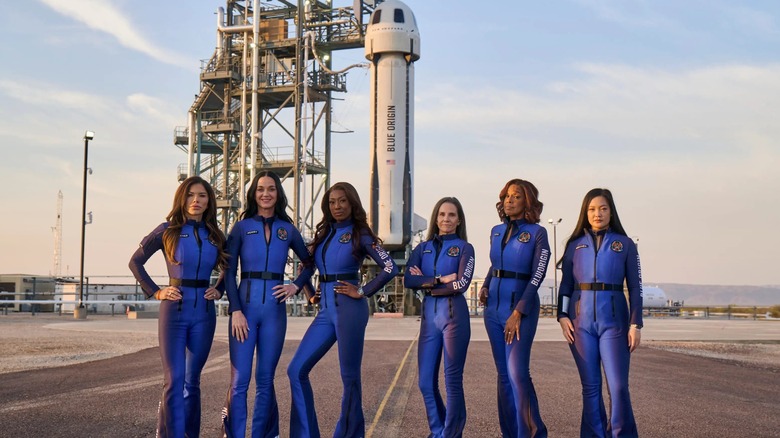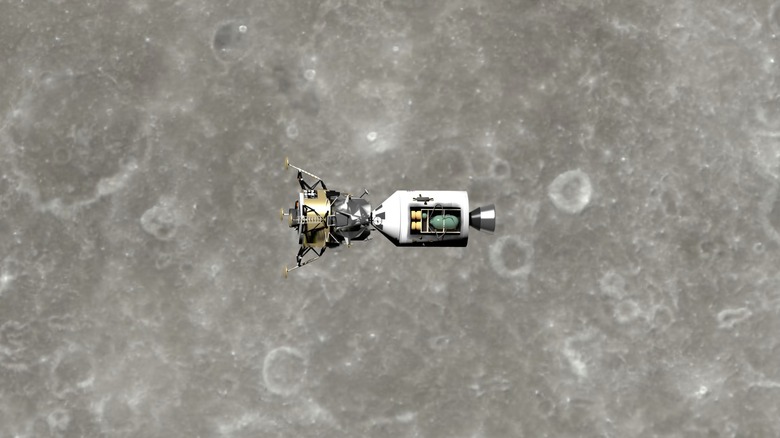Did Blue Origin's New Shepard Rocket Actually Leave The Atmosphere?
Blue Origin's latest private mission to space made bigger headlines than usual — but the buzz surrounding the flight had more to do with its celebrity crew rather than any record-breaking or scientific achievements. This crew included broadcast journalist Gayle King and pop star Katy Perry. It was also the first all-women spaceflight since 1963 (which was a solo mission). This was the 31st mission overall and 11th human spaceflight mission for the New Shepard, a reusable rocket designed by Blue Origin — the private space technology company started by Amazon founder Jeff Bezos in 2000.
The New Shepard is named after Alan Shepard, the first American in space, which is in line with Blue Origin's history of naming spacecraft after notable astronauts. Like other flights, this mission — NS-31 — was given its own unique patch, which reflected the contributions of each of its members — besides King and Perry, the crew included Aisha Bowe, Amanda Nguyễn, Kerianne Flynn, and Lauren Sánchez. Launched on the morning of April 14, 2025, the flight was a pretty short one — it lasted a little over 10 minutes and did not complete an orbit of the Earth. However, the New Shepard and its crew rode the rocket long enough to travel 66 miles above the planet's surface. This means, by definition, it entered space.
While Katy Perry and her fellow crewmates can now boast that they've been to space, it would be a little trickier for them to claim that they left the atmosphere. To be fair, the crew reached one of the highest layers of Earth's atmosphere, one which only a very small percentage of humans can say they've been to. However, the edge of space and the end of our atmosphere are considered to be two different places that are surprisingly far apart.
The edge of space begins 62 miles above the Earth's surface
The first time the New Shepard made an altitude of 66 miles was in 2018. Both that mission and NS-31 are considered to have reached space because both surpassed the Kármán line, which exists at 100 km (62 miles) above sea level and is the internationally-recognized altitude where space begins. To date, the New Shepard program has flown 52 people beyond the Kármán line and into space. However, by this definition the edge of space is not the same as the edge of Earth's atmosphere, which consists of several distinguishable layers.
The layer humans live in and where all weather occurs is the troposphere, which consists of 75% of the entire atmosphere and reaches as high as 12 miles above the planet's surface. Above this layer is the stratosphere, which besides being a great metaphor for "really high up," is also as high as traditional military drones can fly. By surpassing the Kármán line and flying 66 miles above Earth, the crew of the NS-31 mission reached the thermosphere, which is still part of the atmosphere, even if it's a very thin layer of gases.
For what it's worth, nearly all astronauts have never flown beyond the thermosphere, so the crew of the NS-31 are in good company. Despite all the interesting things about the International Space Station, it orbits within the thermosphere. To truly escape the atmosphere, a spacecraft would need to leave the outermost layer — the exosphere — which extends a whopping 10,000 km (6,200 miles) above Earth — nearly 10 times as far as the NS-31 rocket flew. The exosphere is where most satellites are stationed, and beyond that is what's considered interplanetary space.
Have any astronauts actually left the Earth's atmosphere?
The highest NASA's retired space shuttle has ever flown was 386 miles, when it set up the Hubble Space Telescope — and even that was just the very beginning of the exosphere. Considering no crewed space missions have flown to the moon since 1972, the fact that Blue Origin's New Shepard rocket didn't technically leave the atmosphere shouldn't be held against it. However, the private space company has its sights set beyond Earth's atmosphere and has entered a partnership with NASA for missions outside of the exosphere.
Data from NASA and the European Space Agency, explain that Earth's outer atmosphere, a cloud of hydrogen called the "geocorona," could reach nearly 391,000 miles into space. The Moon, which orbits roughly 238,855 miles above Earth, is located past the Earth's exosphere. Only 24 astronauts — all American NASA explorers — have traveled to the Moon, and only half that number have walked on its surface. The deepest into space any humans have travelled was when the crew of the infamous Apollo 13 mission went to the dark side of the Moon. No humans to date have gone deeper.
That could change in the near future, though, as NASA's Artemis program plans to land humans on the Moon for the first time since the 1970s. Blue Origin is set to play a key role in future Artemis missions and has already been commissioned by NASA to build a lunar lander intended for both crew and cargo. If successful, this will be a giant leap forward for the private space industry, though it's currently unclear if Katy Perry will be one of the next astronauts to walk on the Moon.


